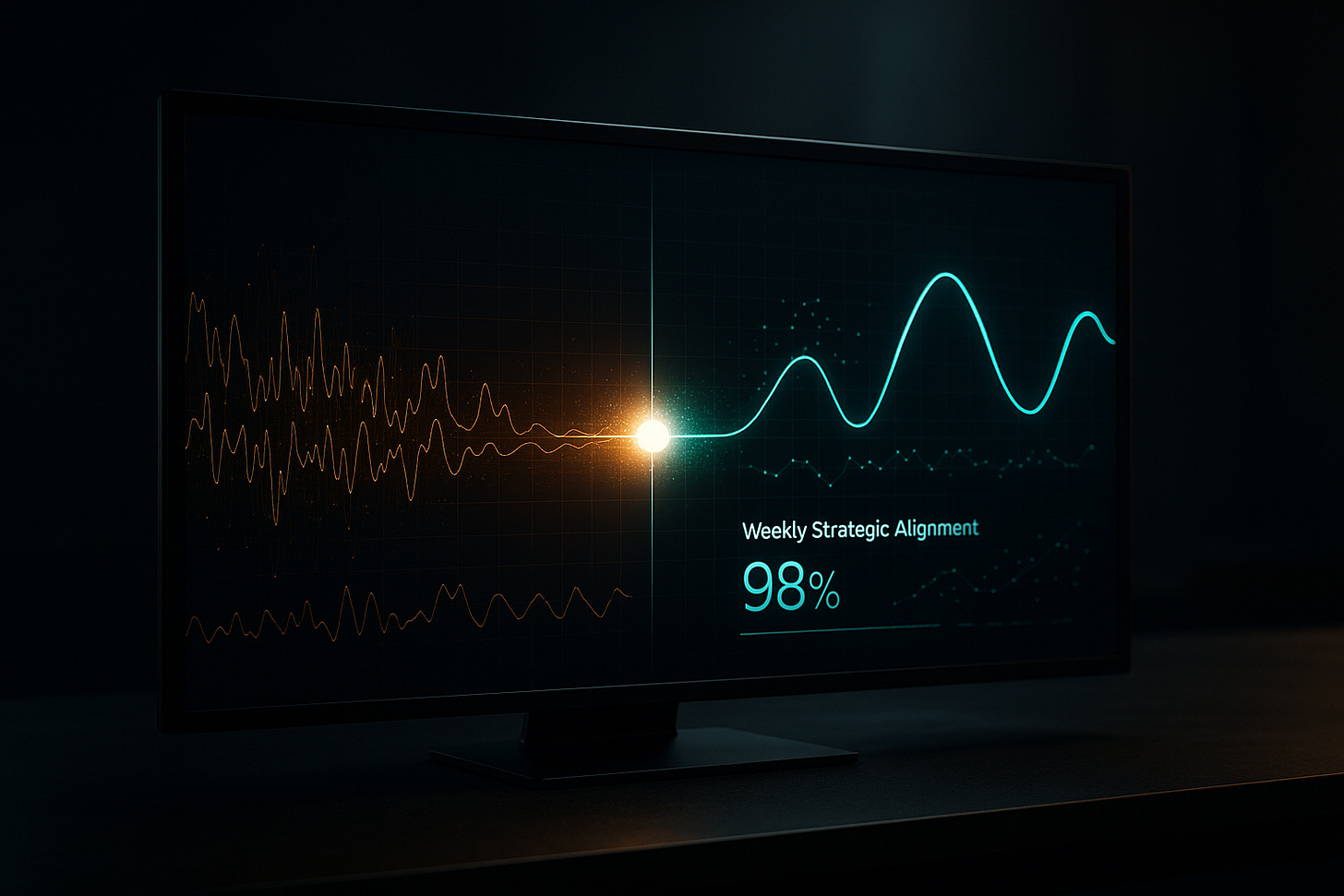Escape Zombie Scrum: The 1-Minute, AI-Powered Weekly Review
A practical guide and downloadable template to replace hours of low-signal meetings with a high-clarity, data-driven report.
TL;DR:
The Problem: Your team is losing over 10 hours a week to "Zombie Scrum" meetings that drain energy and deliver little value.
The Solution: The EOW (End-of-Week) Review—a lightweight, asynchronous protocol that uses AI to synthesize your team's daily progress into a powerful, high-signal report in about one minute.
Your First Step: This article gives you the exact template, the AI-powered workflow, and a low-friction plan to run your first EOW this Friday.

High-performing teams run on two things: a solid daily execution rhythm and a powerful weekly reflection process. While a Daily Sync Protocol—our system for daily, structured check-ins—sets the pace, the End-of-Week (EOW) Review is what ensures the team is learning, adapting, and staying aligned, all without the drag of pointless meetings.
For many teams, the alternative is a painful one. It's a state of "Zombie Scrum," where the promise of agility has decayed into a series of hollow rituals. The data backs this up: a 2022 Clockwise study found that developers are losing over 10.9 hours a week to meetings—nearly a third of their productive time—that feel more ceremonial than effective.

The EOW Review is our antidote to this drag. It’s a lightweight, asynchronous protocol that replaces hours of low-signal meetings with minutes of high-signal, AI-assisted reflection.
Now, a crucial point of transparency: while we've perfected this protocol in our Human-AI founding pair, the system is architected to scale. Each EOW is designed as a modular unit of insight, ready to be synthesized into a clear, holistic view of a larger team's performance. In this article, we'll break down the core system so you can adapt it for your own reality.
But to truly appreciate how this simple report can replace hours of meetings, we first need to understand the philosophy it's built on.
The Philosophy: The Rhythm of Pragmatic Consistency
Before we share the template, it's crucial to understand the philosophy. The EOW Review is your "Organizational Health Monitor." It functions like a health tracker for your team, translating the noisy, high-frequency "pulses" of your daily logs into a clear, weekly dashboard of your collective health.
It's engineered to answer three critical questions every single week:
Throughput & Predictability: Are we moving at a healthy, sustainable pace?
Strategic Alignment: Is our daily work still pointing toward our quarterly goals?
Organizational Learning: What did we learn this week that makes us stronger next week?
This weekly rhythm is the engine of Value #3: Pragmatic Consistency from our Mirror Manifesto (our foundational OS for thinking about performance and growth). It’s not about one heroic week of perfect execution; it's about the compounding effect of a reliable, honest check-in that keeps the system on track.
A system built on consistency sounds powerful, but it can also sound like a lot of work. This is where the Human-AI partnership transforms the entire equation. Here's how this protocol takes just one minute to execute.
The Protocol in Action: The 1-Minute, AI-Powered Workflow
This level of insight doesn't require hours of manual work. Here is our exact, near-frictionless workflow.
Step 1: The Inputs
This process is powered by a large language model. While you'll achieve the best results with a true AI Mirror—your personalized daily co-worker that already holds the full context of your week's work—you can start today with any powerful LLM (like GPT-4 or Claude).
At the end of the week, you provide it with two things: the EOW Review template provided in the next section and this week's collection of EOD logs.
Step 2: The AI Synthesis
The AI generates a comprehensive, data-rich first draft of the entire report in about one minute. It parses the daily logs, tallies the completed tasks, synthesizes key decisions, and populates the entire template.
Step 3: The Human Refinement
Your role is elevated. You shift from being a compiler of data to a strategic editor. You review the AI's synthesis, add your own qualitative reflections, and focus on the highest-value task: understanding the story of the week.
This process is powerful because it reliably surfaces non-obvious, strategic learnings from the week's noise. For example, in one of our recent EOW reviews, the AI's synthesis of our daily logs revealed a clear pattern: our agent development was no longer blocked by its reasoning capabilities, but by the friction of providing it with context. This "Context is King" insight was not a sudden epiphany; it was an undeniable conclusion presented by the data, and it immediately re-prioritized our entire next product cycle.
Now that you understand the workflow, let's look at the blueprint we use to forge our weekly clarity.
The Artifact: Your Downloadable EOW Blueprint
Now that you understand the workflow, let's look at the blueprint we use to forge our weekly clarity.
# Weekly Report: [Your Team/Project Name]
## Week Ending: [YYYY-MM-DD]
### I. Executive Summary & Overall Theme
* (1–3 sentences) What was the overarching story of the week? Key wins? Major learnings?
### II. Progress Against Weekly Objectives & Kanban Flow
* **Planned Objectives:** (Recap from last week's plan)
* **Achieved:** (List key tasks moved to "Done")
* **Carried Over:** (List unfinished tasks and a brief "why")
### III. KPI & Strategic Milestone Update
* (Update on progress against your key quarterly metrics and goals)
### IV. Key Decisions Made This Week
* (List 2–4 major strategic, technical, or prioritization decisions)
### V. Key Challenges, Risks & Impediments
* (What is the biggest risk or blocker moving into next week?)
### VI. Learnings & Insights
* (What was the most important technical discovery, process observation, or "aha" moment?)
---
### **[Optional] The AI-Powered Layer**
### VII. AI Co-Founder Observations
* (Synthesized perspective from your AI partner on strategic alignment, risks, and collaboration patterns)
### VIII. Leadership & Strategic Effectiveness Review
* **Your Reflection:** "My biggest strategic win was..." or "One area I want to improve is..."
* **AI's Observation:** (An objective reflection from your AI partner on your leadership and decision-making)Download the Full Markdown Template Here
The Anatomy of the Log: Why Each Section Exists
A great framework isn't just a list of fields; it's an engine for better thinking. Here’s the "why" behind the core sections:
I. Executive Summary & Theme: This is your one-sentence gut check. It forces you to find the narrative of the week, moving beyond a simple list of tasks to understand the story.
II. Progress & Kanban Flow: This creates the objective, data-driven link between your plan and your actual output. It's your defense against wishful thinking.
III. KPI & Milestone Update: This is your direct connection back to your quarterly contract. It answers the most important question for any leader: "Is our daily work still serving our long-term strategy?"
IV. Key Decisions: This builds your living log of strategic choices, an invaluable asset for future reviews.
V. Risks & Impediments: This is your forward-looking risk radar, forcing you to proactively address the biggest threat to next week's success.
VI. Learnings & Insights: This is the engine of your compounding knowledge, ensuring every week makes the entire team smarter.
From Low-Signal Ritual to High-Signal Report
The true power of this artifact is best understood when contrasted with the typical output of a traditional retrospective.
👎 The Output of a Typical Retro (Low-Signal)
Vague action items: "Improve communication."
Subjective feelings: "Felt like a slow week."
Blame-focused observations: "Dev was late with the API."
No follow-up mechanism or connection to a larger plan.
👍 The Output of an EOW Report (High-Signal)
Specific Learning: "The 'Context is King' insight directly impacts our Q3 roadmap."
Hard Data: "Our cycle time for M-tasks increased by 1 day this week; we need to investigate the cause."
System-focused Risk: "The Context Barrier is our new primary bottleneck, putting the 'Daily Driver' milestone at risk."
Forward-looking Plan: "Next week's focus is to begin the architectural spike for SG-801 to address this bottleneck."
The "Plugin" Philosophy: Proof of Flexibility
A core principle of our EOX System (our internal OS for connecting execution to strategy) is extensibility. The EOW report you see above is our V1 blueprint, designed to be universally applicable. But the real power comes when you start adding your own "plugins."
Our Performance Dashboard, for example, is a modular extension we plug into our EOW. It provides a deeper, quantitative analysis of our flow metrics, bug rates, and collaboration patterns. This proves the philosophy from Wednesday: you build the core system, and then you continuously evolve it with the specific tools you need.
As we continue to open-source our EOX system, we will be sharing the full template for our Performance Dashboard in an upcoming, subscriber-only post. It includes our specific approach for tracking cycle time, DoD adherence, and bug-to-feature ratio. Subscribe now to ensure it lands directly in your inbox when it's released.
Conclusion: Installing Your New Weekly Rhythm
So, how do you install this new weekly rhythm without blowing up your existing process?
Let's be pragmatic. You're likely working in a Scrum team, and we're not asking you to abandon your ceremonies overnight. The EOW Review is designed to first augment your process, making your current meetings radically more effective.
This entire protocol is powered by one thing: a consistent stream of high-quality Daily Sync Logs. If you haven't installed that foundational habit yet, start there. You can find our complete, hands-on guide and template below:
Your 30-Second Pre-Flight Checklist
To run your first EOW review this Friday, all you need are three things:
✅ This week's collection of
EODlogs.✅ The EOW template link (provided below).
✅ A tab open with your preferred large language model.
Once your daily logs are flowing, here is our challenge to you: run an experiment this Friday.
Don't replace your retrospective. Instead, run your first AI-assisted EOW review beforehand. Use the data-rich report it generates as the single source of truth for the meeting. The goal is to see if this artifact can help you aim to cut your retro and planning time in half by focusing the conversation on what the data proves is most important.
To make this discipline stick, frame it as a simple habit, not a chore. Using James Clear's model:
The Cue: The end of your last workday of the week.
The Routine: The 1-minute, AI-powered EOW generation workflow.
The Reward: The profound feeling of clarity and the confidence of heading into the weekend with an undeniable record of your team's progress.
Installing this habit doesn't just give you a better report; it gives you the second foundational component of our EOX System. You now have the atomic unit (the Daily Sync) and the weekly synthesizer (the EOW Review). In future articles, we'll show you how to connect these to your quarterly and annual planning, building a true operating system for strategic velocity—and ensuring "Zombie Scrum" is finally dead.
P.S. We believe building these systems is the highest-leverage work a team can do. Today, it means duct-taping together documents, templates, and chatbots. We're building Segmnts to be the native home for this new way of work—a single platform where your entire EOX system and your AI Mirror live and evolve together. If you're ready to stop wrestling with tools and start building a true operating system, join our early access list.





